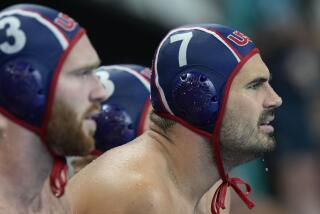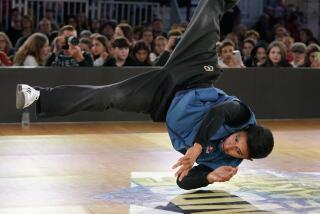Winter Olympics : East German, Soviet Athletes, Swiss Skiers Expected to Dominate
- Share via
CALGARY, Alberta — The most spectacular winter sports festival of all returns to North America Feb. 13-28 and this time will serve as a showcase for Swiss skiers and the finely-trained athletes from the Soviet Union and East Germany.
Unlike Lake Placid in 1980, when a heroic hockey team and speedskater Eric Heiden gave the host country so much to be proud of, or even Sarajevo four years ago, the United States is expected to do little of note in the 15th Winter Olympics. Even while they appear on prime time television, U.S. athletes would be fortunate to approach the eight medals they garnered in the 1984 Games.
The closest resemblance to war in Switzerland takes place on the mountainsides, and several internecine skirmishes can be anticipated in Calgary. The Swiss are far and away the strongest alpine team, and very well may come away with seven or eight of the 10 gold medals at stake.
Indeed, in some of the races the Swiss are expected to be battling each other rather than the rest of the world.
East Germany, which features the charming figure skater Katarina Witt, and the Soviet Union, with gold medal potential in at least seven sports, should duel once again for the unofficial medal championship. At Sarajevo, the East Germans led all countries with nine gold to six for the Soviet Union, although the Soviets came out on top in total medals, 25-24.
The United States earned four gold medals in 1984, three in alpine, and its overall count of eight medals tied Sweden for fifth place in the standings. The situation has gone downhill since, particularly on the ski slopes.
More than the usual rivalry exists on the Swiss alpine team, both among the men and women. Pirmin Zurbriggen, who conceivably can win a record four gold medals, is not on the best of terms with compatriot Peter Mueller, and the same applies to Michela Figini, the defending downhill champion, and Maria Walliser, who won the 1987 world championship downhill and super giant slalom races over Figini.
“He goes to bed so early in the evening,” Mueller said of Zurbriggen. “He never drinks anything in the bar, so it’s difficult to talk to him. We are too different.”
Similarly, the more emotional and unpredictable Figini says of Walliser, “Sure, she is not my best friend. But it’s not possible as we have such different characters.”
Zurbriggen, who has overtaken the early season sensation, Italian Alberto Tomba, in the World Cup standings, is the defending world champion in the giant slalom and super-giant slalom and has dominated the downhill this season. He also ranks among the top favorites for the combined, making its return to the Olympic program after 52 years.
Toni Sailer of Austria in 1956 and Jean-Claude Killy of France in 1968 are the only Alpine skiers to capture three gold medals in a single Olympics, and this is a mark the 25-year-old Zurbriggen can match or surpass.
“I would love to win an Olympic medal but it won’t be the end of the world if I fail,” said Zurbriggen, who is deeply religious. “There are things that are more important in life, like good health and the family.”
The United States alpine team accounted for three gold medals and two silver at Sarajevo, a sensational performance which will stand out even more this month by a contrasting failure. Despite the availability of 12 more alpine medals at Calgary with the addition of the Super G and combined for men and women, there is little likelihood of a single U.S. medal.
Bill Johnson, the flamboyant downhill gold medalist at Sarajevo, failed to recover form following knee surgery last season and failed to make the U.S. team. Only one man on the squad, Tiger Shaw of Burlington, Vt., has previous Olympic experience, and he didn’t even finish in the slalom or giant slalom in 1984.
Returning to the women’s team from 1984 are Debbie Armstrong, the giant slalom gold medalist, and Tamara McKinney, both of whom suffered serious injuries. McKinney, a veteran of two Olympics, has not competed in a race since breaking her leg last fall.
Tomba, winner of seven slalom and giant slalom races this season, is a definite threat to take away some of the Swiss glory at Calgary, although he has been in a slump recently. Other medal candidates include Guenther Mader, Hubert Strolz, Rodolf Nierlich and Helmut Mayer of Austria, Rob Boyd of Canada, Markus Wasmeier of West Germany and Richard Pramotton of Italy.
The focal point for the United States will be in figure skating, where former world champions Debi Thomas and Brian Boitano both have excellent chances for gold. In each case, though, the U.S. skater must contend with the current world champion, Witt and Canadian Brian Orser.
Jill Trenary, who won the U.S. championship from Thomas a year ago, and handed it back again at Denver last month, also is a medal threat as is a third American, Caryn Kadavy, the bronze medalist at last year’s worlds.
Alexander Fadeev of the Soviet Union is another strong medal candidate among the men, and the Russians should capture gold in both pairs and ice skating.
Speed skating is the other sport in which the United States can show well, although it won’t dominate. Bonnie Blair, at 500 meters, is the best American hope to capture gold, while Nick Thometz, Dan Jansen and Eric Flaim all have the potential to win medals in the men’s division.
East Germany won 11 speedskating medals at Sarajevo, and once again should be strong. East German women, led by Karin Kania-Enke, Christa Rothenburger and Andrea Ehrig, are capable of winning as many as a dozen medals.
The U.S. hockey team is in a group with two perennial powers, the Soviet Union and Czechoslovakia, as well as Austria, Norway and West Germany. The top three from that division will advance to the medal round. Canada, following its victory earlier this winter in the Izvestia Tournament in Moscow, and the option to add NHL players, is a strong medal candidate.
Nordic skiing long has been influenced by the Scandinavian countries, and they once again should rule. Gunde Svan, Torgny Mogren and Thomas Wassberg of Sweden are among the favorites in cross country, while Norway, the Soviet Union, East Germany and Finland should share in the women’s medals.
Matti Nykaenen of Finland, winner of a gold and silver medal at Sarajevo, Pavel Ploc and Jiri Parma of Czechoslovakia and Jens Weissflog of East Germany represent the best among the ski jumpers.
The Calgary Games represent the first true opportunity for an American to earn medals in biathlon and luge. Josh Thompson made a big breakthrough in biathlon last February when he placed second in the 20 kilometers at Lake Placid, becoming the first American to earn a medal in the World Championships. No U.S. biathlete has been in the top 10 in Olympic competition, but the 25-year-old Thompson has a realistic shot at taking a medal.
Frank-Peter Roetsch of West Germany, the 1986-87 World Cup champion, won the 10 and 20 kilometers and also was on the winning relay team at the 1987 World Championships, duplicating the feat achieved a year earlier by Valery Medbetsev of the Soviet Union. The Soviets have the strongest team in the world, including Medbetsev and Yuri Kachkarov, winner of the 10 kilometer at last year’s World Cup event at Canmore, site of the Olympic Nordic events.
Peter Angerer of West Germany, winner of three medals at the 1984 Olympics, could be a factor once again.
Bonny Warner, a veteran of the 1984 U.S. luge team, and Cammy Myler posted a 1-3 finish in the final World Cup event of the 1986-87 season at Lake Placid, N.Y., giving Myler her second bronze of the campaign. Warner has a darkhorse chance for a medal.
Medal favorites in luge include Rene Friedl and Thomas Jacob of East Germany, Norbert Huber and Paul Hildgartner of Italy, Markus Prock of Austria, and Yuri Harchenko and Sergi Danilin of the Soviet Union. The best American man could be 19-year-old Duncan Kennedy. The East Germans are very strong in the women’s race with Cerstin Schmidt, considered to be No. 1 in the world, Gabriella Kohlisch, Uta Oberhoffner and Steffi Martin Walter.
Not since 1956 has the United States won an Olympic medal in bobsledding, and it isn’t likely this will change at Calgary, where the Soviet Union, East Germany and Switzerland should dominate.
More to Read
Go beyond the scoreboard
Get the latest on L.A.'s teams in the daily Sports Report newsletter.
You may occasionally receive promotional content from the Los Angeles Times.






